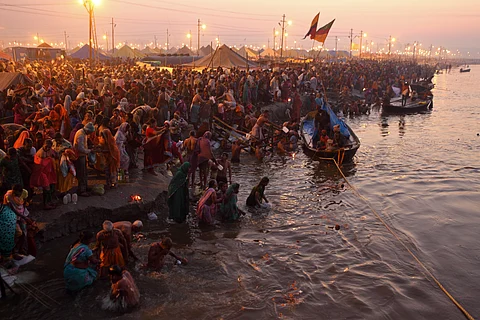

Are the waters of the Ganga river in Prayagraj, Uttar Pradesh, during the ongoing Mahakumbh completely clean? According to media reports, by 3 PM on January 14, 25 million devotees had bathed at the Sangam.
As per the National Green Tribunal’s (NGT) directives, these devotees should have been informed about the quality of the water they were about to dip into. However, Down To Earth (DTE) has learnt that it is not being done.
In its order of December 2024, the NGT stated that during the Mahakumbh, there should be adequate availability of Ganga water in Prayagraj, and its quality should be suitable for drinking, sipping, and bathing.
Given the vast crowds attending the festival during Makar Sankranti, the Ganga’s smaller streams have not been fully cleaned, even though millions of people are gathered in a few kilometres’ radius around Prayagraj.
According to the Central Pollution Control Board’s (CPCB) real-time water quality monitoring system, the Biological Oxygen Demand (BOD) level at the Prayagraj Sangam was measured at four mg per ml, exceeding the normal limit of 3 mg per ml by 2 pm on January 14, 2025.
A higher BOD indicates a higher concentration of organic matter in the water, signifying poor water quality.
As per the Uttar Pradesh Pollution Control Board (UPPCB), the BOD for organised bathing should not exceed 3 mg per litre at 20°C over a five-day period.
Despite continuous water discharge to improve the flow in the river, this outcome is concerning. It suggests that sewage management through drains or sewage treatment plants (STPs) is not being carried out effectively.
Previous order from the NGT mandates that devotees should be informed of the quality of the Ganga’s water in real-time through online displays, 24 hours a day. However, the platform called Sustainability of River Ganga Water designed for this purpose is not functioning.
Moreover, the UPPCB’s website only provides water quality data until November 2024.
This is not the first time such issues have been raised. In 2019, the CPCB’s report on the Kumbh in Prayagraj clearly indicated that the water quality was poor, even on major bathing days.
The CPCB’s report, ‘Environmental Footprints of Mass Bathing on Water Quality of River Ganga during Kumbh Mela’ highlighted this issue.
During the 2019 Kumbh Mela, 130.2 million people participated. According to the report, BOD and fecal coliform levels at Karsar Ghat were found to be above acceptable limits. On major bathing days, BOD levels were significantly higher in the morning compared to the evening. Additionally, on Mahashivaratri and subsequent days, fecal coliform levels exceeded the standards both in the morning and evening.
The dissolved oxygen levels in the Yamuna River met the standards throughout, but pH, BOD, and fecal coliform were not consistently within acceptable limits on various occasions. Among the tributaries of the Ganga, the Kali River was found to be the most polluted.
Alarmingly, even at the Sangam, where people specifically bathe, the water remained polluted during the Kumbh.
According to the report, the monitoring of Ganga river water quality at the Sangam was carried out twice daily, in the morning and evening. The report noted two major points:
Firstly, in the morning, the water quality of the Ganga met external bathing water quality standards for dissolved oxygen (DO) on all occasions, but pH (6 occasions), BOD (16 occasions), and fecal coliform (6 occasions) did not meet the standards.
Secondly, in the evening, DO met the bathing standards on all occasions, but pH (six occasions), BOD (15 occasions), and fecal coliform (six occasions) did not meet the required standards. Additionally, on most auspicious bathing days, BOD levels at the Sangam were considerably higher in the evening compared to the morning.
Moreover, on Mahashivaratri and subsequent days, fecal coliform levels were found to exceed the bathing standards both in the morning and evening.
The conductivity of river water is typically between 100 and 1,000 microsiemens per centimetre. At present, the conductivity at the Sangam is 704 microsiemens per centimetre, which is considered good. However, as the discharge decreases, this could further deteriorate the water quality.